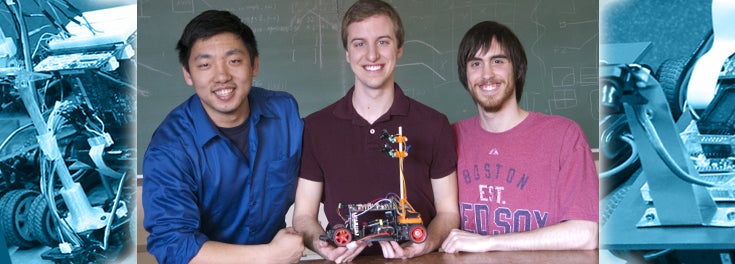
A car with a mind of its own may sound like science fiction, but at URI, computer engineering students are proving that it’s already a reality. And they’ll soon be proving it to the world. Three URI students designed and built an autonomous model race car that took first place in a national competition, and they’re representing the United States this summer at the world championships.
Competing at the annual Freescale Cup in Rochester, N.Y. in April, the foot-tall car relied on a camera and software programmed by the students to zip along a curvy and hilly racetrack without human intervention. It completed the course in 17.7 seconds, faster than 27 other teams. The URI students now head to South Korea in August to compete against 19 teams from around the globe.
This is a good opportunity to inspire students to do real design. The best way to learn is by doing. ~Professor Qing Yang
“It was amazing,” said team member Geoffrey Mcelroy ’14. “It’s one of those once-in-a-lifetime opportunities.”
Geoff and teammates Cory Jalbert ’14 and David Cipoletta ’14 were classmates in a senior computer engineering course. Professor Qing Yang offered his students a choice for grading: take a series of traditional exams or design a robotic car and take one exam. Six students opted for the latter, fielding two teams that competed in Rochester. “This is a good opportunity to inspire students to do real design,” Professor Yang said. “The best way to learn is by doing.”
The students programmed a 32-bit microprocessor to interface with a camera, motor, battery, wheels and sensors. They added intelligence by creating algorithms that learned from previous mistakes and kept the car on the 100-foot track. “Even if the track had been constantly changing, the car would have been able to adapt and handle it,” said Cory.
This isn’t the first year that Professor Yang has encouraged students to enter the competition, and it’s not the first year the team met with great success. Last year’s team placed second in the nation, narrowly losing to a team from the University of California at Berkeley.
The URI teams worked long hours – longer than they would have studied for the exams they avoided – to ensure the cars would run fast and true. Pushing for even faster speeds, this year’s winning team at one point even worked more than 16 hours straight to finalize their car’s design. And now they’re back at it, tweaking the car ahead of the world championships, even after two of them graduated in May.
It’s not all for the fun of the competition, though. All of the students agreed that the project had practical applications, too, especially for their future engineering careers. “I really liked that it was applicable to the outside world,” said Jillian Burgess ’13, a member of last year’s second place team. “I liked how we applied what we learned to a real-world problem. Putting it all together gives us a great perspective on how we can use what we’ve learned in the future.”
